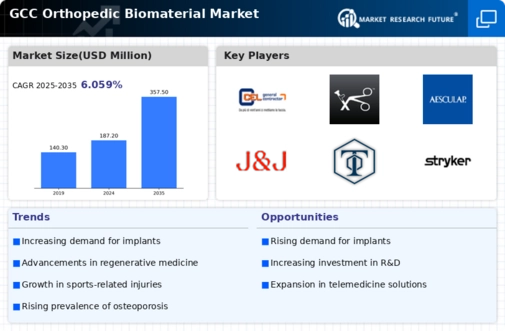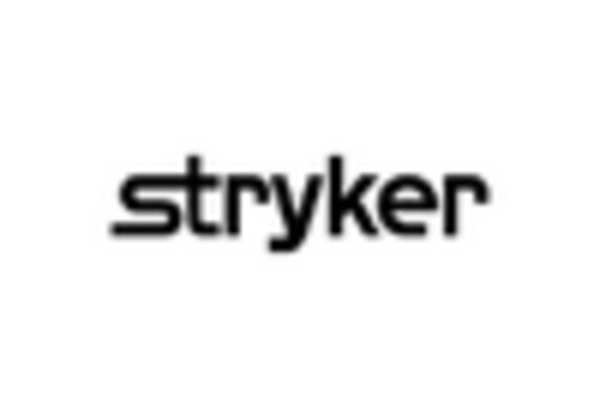The orthopedic biomaterial market is currently characterized by a dynamic competitive landscape, driven by innovation, strategic partnerships, and regional expansion. Key players such as DePuy Synthes (US), Stryker (US), and Zimmer Biomet (US) are at the forefront, each adopting distinct strategies to enhance their market presence. DePuy Synthes (US) focuses on innovation through advanced product development, particularly in joint reconstruction and trauma solutions. Stryker (US) emphasizes digital transformation, integrating AI and robotics into its surgical offerings, while Zimmer Biomet (US) is actively pursuing mergers and acquisitions to bolster its portfolio and expand its global reach. Collectively, these strategies contribute to a competitive environment that is increasingly centered on technological advancement and comprehensive service offerings.
In terms of business tactics, companies are localizing manufacturing to reduce costs and enhance supply chain efficiency. This approach is particularly relevant in the GCC region, where logistical challenges can impact product availability. The market structure appears moderately fragmented, with several key players holding substantial market shares, yet numerous smaller firms also contribute to the competitive dynamics. The collective influence of these major companies shapes pricing strategies and innovation cycles, fostering a competitive atmosphere that encourages continuous improvement.
In October 2025, Stryker (US) announced a strategic partnership with a leading AI firm to enhance its surgical robotics capabilities. This collaboration aims to integrate advanced machine learning algorithms into Stryker's existing robotic systems, potentially revolutionizing surgical precision and patient outcomes. The strategic importance of this move lies in Stryker's commitment to maintaining its competitive edge through technological innovation, which is increasingly becoming a critical factor in the orthopedic biomaterial market.
In September 2025, Zimmer Biomet (US) launched a new line of biodegradable orthopedic implants designed to reduce the need for secondary surgeries. This initiative not only addresses patient safety and recovery times but also aligns with the growing trend towards sustainability in medical devices. The introduction of these implants signifies Zimmer Biomet's proactive approach to meeting evolving market demands and regulatory pressures, thereby enhancing its market position.
In August 2025, DePuy Synthes (US) expanded its product offerings by acquiring a startup specializing in 3D printing technologies for orthopedic applications. This acquisition is expected to enhance DePuy Synthes's capabilities in personalized medicine, allowing for the production of customized implants tailored to individual patient anatomies. The strategic importance of this acquisition lies in its potential to differentiate DePuy Synthes in a competitive market increasingly focused on personalized healthcare solutions.
As of November 2025, current trends in the orthopedic biomaterial market include a pronounced shift towards digitalization, sustainability, and the integration of AI technologies. Strategic alliances are becoming increasingly vital, as companies seek to leverage complementary strengths to enhance their product offerings and market reach. Looking ahead, competitive differentiation is likely to evolve from traditional price-based competition to a focus on innovation, technological advancements, and supply chain reliability. This shift underscores the importance of agility and responsiveness in a rapidly changing market landscape.

















Leave a Comment